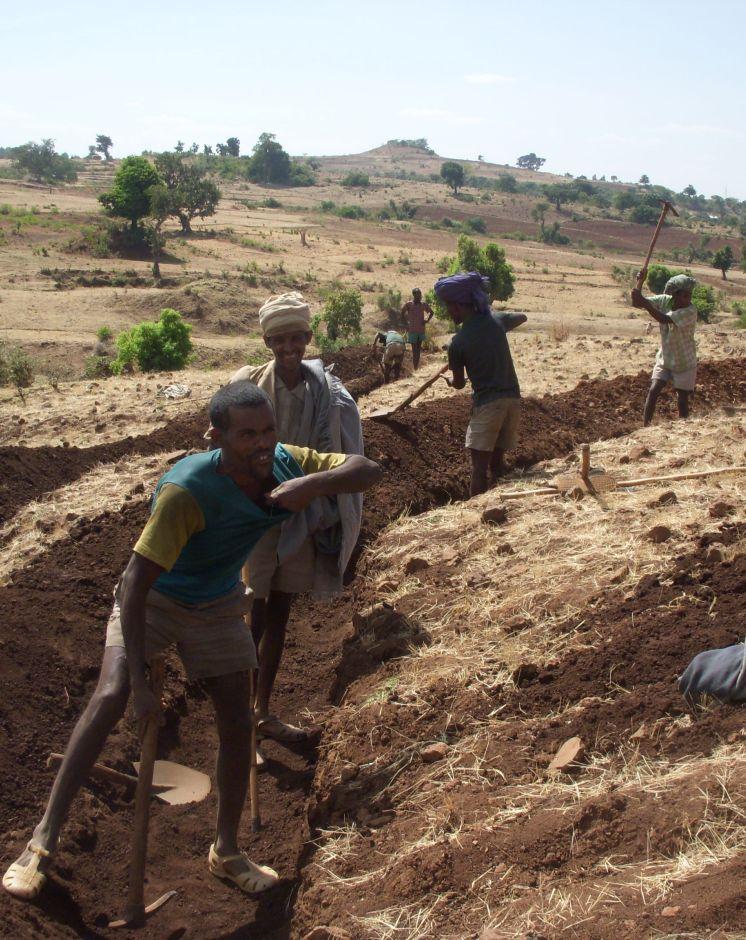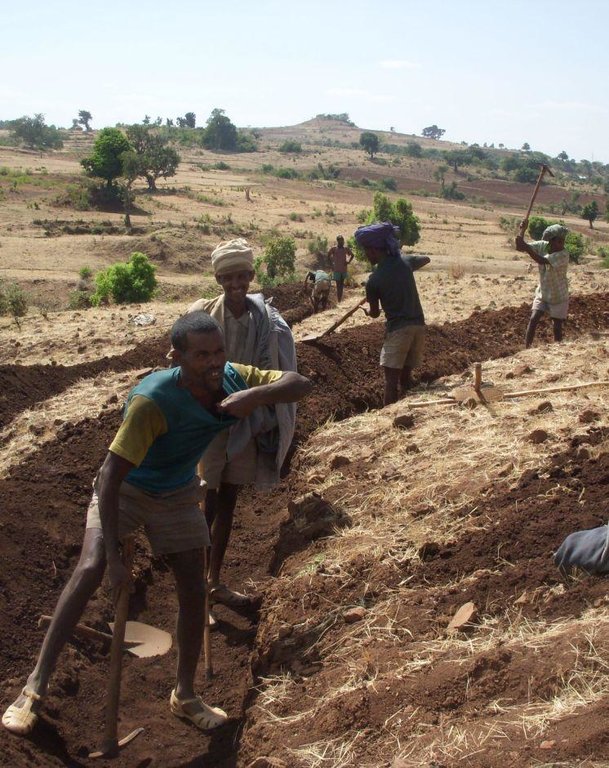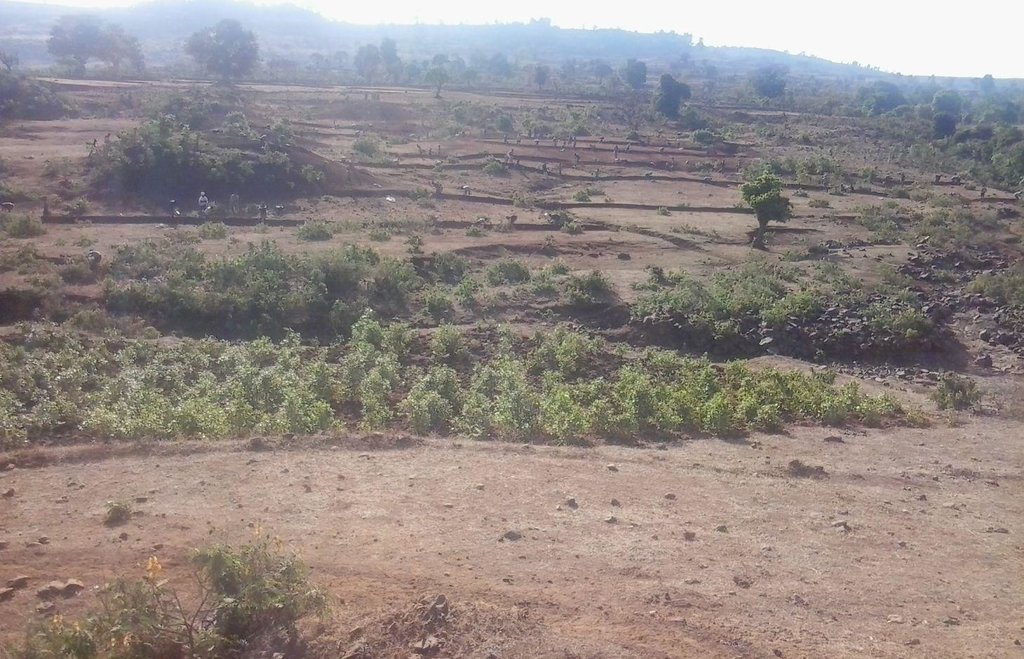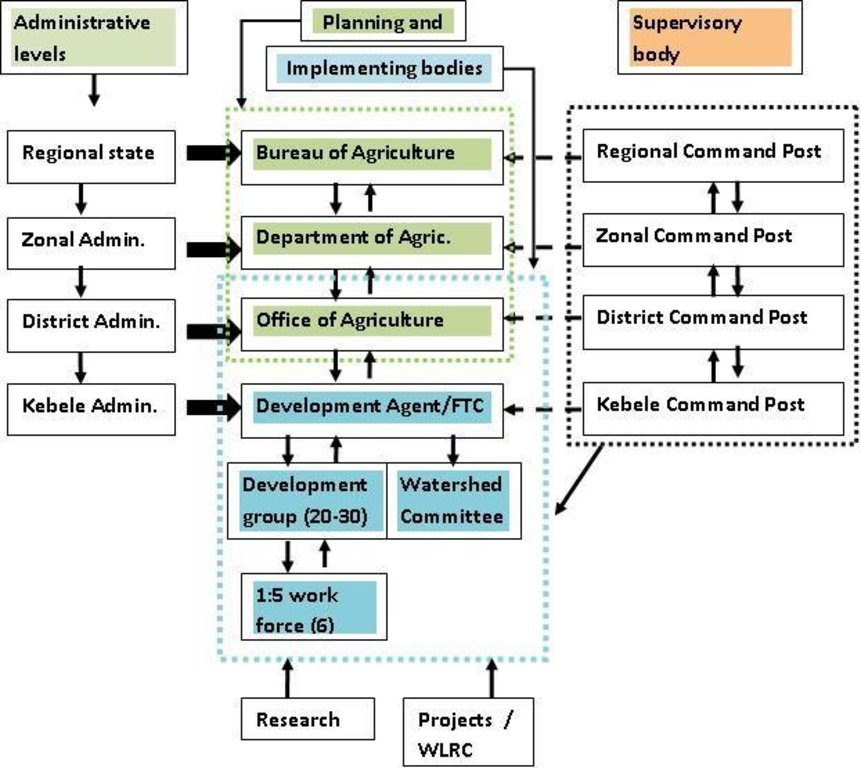Community Organizations and Mobilization for Soil and Water Conservation Work (COM-SWC) [أثيوبيا]
- تاريخ الإنشاء:
- تحديث:
- جامع المعلومات: Gizaw Desta Gessesse
- المحرر: –
- المُراجع: Fabian Ottiger
Mass Mobilization (English) or aferna wuha tibeka zemecha (Amharic)
approaches_2495 - أثيوبيا
عرض الأقسام
توسيع الكل طي الكل1. معلومات عامة
1.2 تفاصيل الاتصال بالأشخاص الرئيسيين لمصدر المعلومات والمؤسسات المعنية بتقييم وتوثيق النهج
متخصص في الإدارة المستدامة للأراضي:
Melese Bekure
WLRC
أثيوبيا
متخصص في الإدارة المستدامة للأراضي:
Endashaw Aytenew
aytenewendeshaw@yahoo.com'
BoA/Amhara
أثيوبيا
اسم المؤسسة (المؤسسات) التي سهلت توثيق/تقييم النهج (إذا كان ذلك على صلة)
Water and Land Resource Centre (WLRC) - أثيوبيااسم المؤسسة (المؤسسات) التي سهلت توثيق/تقييم النهج (إذا كان ذلك على صلة)
Amhara national regional state agriculutral bureau (BoA/Amhara) - أثيوبيا1.3 الشروط المتعلقة باستخدام البيانات الموثقة من خلال WOCAT
يوافق جامع المعلومات والشخص (لاشخاص) الرئيسي لمصدر المعلومات على الشروط المتعلقة باستخدام البيانات الموثقة من خلال WOCAT:
نعم
1.4 المراجع الخاصة باستبيان(استبيانات) تقنيات الإدارة المستدامة للأراضي
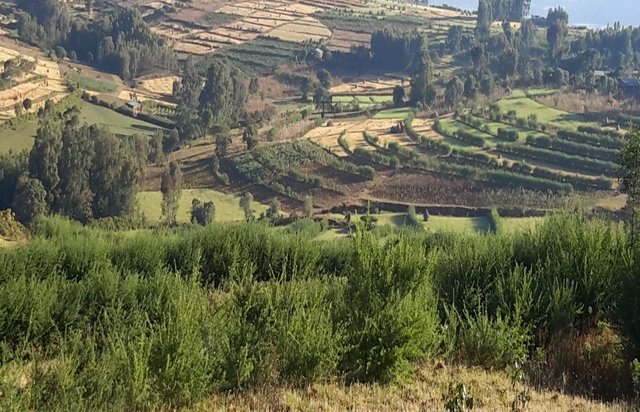
Vegetated graded soil bund [أثيوبيا]
Vegetated graded soil bund is a soil conservation practice meant for cultivated lands and constructed by excavating graded channel on upper side and develop embankment on lower side which is planted with grass or shrub species in order to control soil erosion and drain excess runoff implemented through community mobilization.
- جامع المعلومات: Gizaw Desta Gessesse
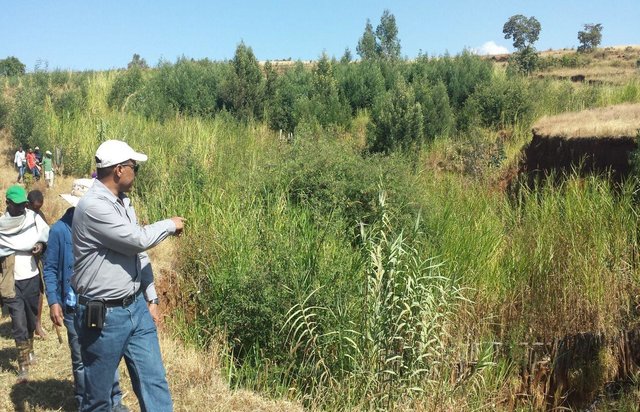
Gully erosion management [أثيوبيا]
Gully erosion management is the application of combination of practices to control excess or concentrated runoff generation in the gully upstream catchment area, divert excess runoff upstream of gully heads and control further development of gully using appropriate structural and vegetative measures in the head, bed and sides of the …
- جامع المعلومات: Gizaw Desta Gessesse

Rehabilitation of Degraded Lands ( Area closure) [أثيوبيا]
Closing the degraded land to let it to regenerate by excluding human and animal interference ans speed up the regeneration process by applying some SWC activities and undertake enrichment plantation.
- جامع المعلومات: Unknown User
2. وصف نهج الإدارة المستدامة للأراضي
2.1 وصف موجز للنهج
Community mobilization for soil and water conservation work in a watershed planning unit is an approach for collective action by organizing all active labor forces living in the kebele/peasant association into development group of 20-30 members and further divide into 1:5 work force to implement construction of soil and water conservation measures, and implementing improved crop production technologies.
2.2 وصف تفصيلي للنهج
وصف تفصيلي للنهج:
Aims / objectives: The objective of this approach is to facilitate and motivate active participation of capable labor forces of the community for constructing soil and water conservation at watershed level for a period of 40-60 days starting from January every year
Methods: At preparation stage, identification of total labor forces and organizing into development groups (20-30 members) and 1:5 work force (6 members) and provision of awareness creation and training activities are carried out. At implementation stage, in reference to the plan, layout of the total physical structures are marked on the ground using line level survey tools. Based on established work norm, Development agents handover the quantity of work plan to all development groups. The development group leader again redistribute the same plan to 1:5 work force proportional to the number of active forces available in it. In principle, all active work forces equally share the work plan. Still, there is division of labor within team and between men and women. Men & women have different work norms. At completion of daily plan, each development group check the quality standard and development agents again take over the constructed structures from Development groups whenever structures meet quality standard as per design and layout. At completion of all watershed development work, development agents transferred the developed watershed to watershed committee in order to handle regulatory functions.
Monitoring and evaluation at implementation stage is clearly defined where 1:5 work team report daily physical work accomplished and number of members involved to the development group while Development group consolidate reports and pass to Development agent in the kebele and again the agent report to district agriculture office, then to zone agriculture office. Simultaneously, the 1:5 groups evaluate the work accomplished within a day and handover to development group which is then consolidated and passed to Development agents once in three days. The development agents summarized and presented to the Kebele command post (KCP) every week. The woreda experts together with District/Woreda command post member assigned in each cluster kebeles further consolidate the evaluation and report to woreda rural command post (WRDCP) and then the command post reflect on the evaluation and provide feed backs weekly to respective kebeles for follow up actio
Stages of implementation: 1. Planning: consulting community for selection of priority watershed, identify labor
2. Preparatory: mobilizing available labor force, hand tools, training,
3. Implementation: constructing planned physical structures
4. Monitoring and evaluation: checking quantity and quality of work done; supervision, field days
5. Sustainability: reinforcing physical structures with biological measures, formulating and enforcing bylaws, establishing user groups
Role of stakeholders: Land user: i) 1:5 work team: is responsible to implement the soil and water conservation work; ii) Development group: lead and evaluate the volume of work divided into the work teams within the group: iii) Watershed committee: is a legitimate body to develop watershed plan with the technical assistant from development agents and experts, as well as responsible for the management and equatable distribution of benefits obtained in the developed watershed.
Development agent: responsible for planning, technical support, training, supervision
Decision makers: The rural Command post, an adhoc formed at kebele, woreda, zone and region level and responsible for the supervision, control and oversight the overall watershed development activities. Sectors such as land use and administration, road authority, water resources, women and youths offices involved as member of command post to ensure integrity of sectors in the watershed development
Research: Research Institutes involved to introduce technologies, assess and evaluate performance of the approaches and technologies applied
NGOs: involved to support trainings, ad
2.3 صور عن النهج
2.5 البلد/المنطقة/المواقع التي تم تطبيق النهج فيها
البلد:
أثيوبيا
المنطقة/الولاية/المحافظة:
Amhara region
مزيد من التفاصيل حول الموقع:
BahirDar Zuria, Dembecha, Mecha, Yilmna Densa, DessieZuria
2.6 تواريخ بدء وإنهاء تنفيذ النهج
أشر إلى سنة البدء:
2010
2.7 نوع النهج
- It is a government initiative reinstitutionalized since 2010
2.8 الغايات/الأهداف الرئيسية للنهج
The Approach focused mainly on SLM with other activities (Plantation of biological conservation measures, application of improved crop and livestock production packages, agricultural implements)
The main objectives of community mobilization is to motivate farming community to take self responsibility to do soil conservation and involve them in public soil conservation work in order to address the problem of land degradation
The SLM Approach addressed the following problems: The main problems targeted to address by the approach are: growing challenges of land degradation and soil erosion; lack of commitment and ownership of soil conservation by farmers; lack of technical knowledge for implementing soil conservation
2.9 الظروف التي تمكن أو تعيق تنفيذ التقنية/التقنيات المطبقة بموجب النهج
المعايير والقيم الاجتماعية /الثقافية/ الدينية
- معيق
Lack of agreement among farmers to do common runoff drainage structures.
Lack of commitment and motivation of land users to do soil conservation on their lands.
Free grazing challenge that lead to unsustainable soil conservation.
Treatment through the SLM Approach: The approach allows to follow watershed principles to integrate different soil conservation measures that safely drain excess runoff.
It also creates awareness and trust building measures and apply public labor to implement SLM technologies. Bylaws are formulated and enforcement mechanisms are arranged through watershed committees to control free grazing
توفر/الوصول إلى الموارد والخدمات المالية
- معيق
High labor cost to construct physical soil conservation measures;
High initial investment to rehabilitate gullies and plant seedling materials;
Lack of credit service for soil conservation investment.
Treatment through the SLM Approach: The government provide hand tools and supply seeds or seedlings to implement biological measures on bunds, gullies, and area closures
الإطار المؤسساتي
- معيق
There are no local institutions/ community based organizations that capable to lead watershed implementation, manage developed watersheds, control and regulate free grazing and benefit sharing generated from communal land resources
Treatment through the SLM Approach: The approach attempts to establish legal body called watershed users association as a legal institution to administer developed watersheds and regulate the utilization of benefits on communal land resources.
Community based organizations such as development group and 1:5 work force are established for enhancing soil conservation implementations
الإطار القانوني (حيازة الأراضي، وحقوق استخدام الأراضي والمياه)
- معيق
Restricted individual ownership or use right to do long term investment
Open access to communal land resources
Treatment through the SLM Approach: The approach enables to provide group use rights for the benefits such as fodder, hay and tree generated on communal land resources upon agreement through establishing user groups. It suggested to formalize the watershed users association at local level as a legal body to administer and regulate the developed watersheds, benefit sharing mechanisms and control of free grazing
The existing land ownership, land use rights / water rights moderately hindered the approach implementation There is no either individual or group entitlement of use rights for communal lands where communal grazing is taking place. Since there is culture of open grazing (animals allowed to graze freely) and pasture lands are communally used, this tradition affects the sustainability of the approach. Although there are community bylaws attempted to be enforced by watershed committees, farmers not yet fully practice cut and carry system of grazing.
المعرفة حول الإدارة المستدامة للأراضي، والوصول إلى الدعم الفني
- معيق
Lack of technical knowledge of farmers and local level organizations
Treatment through the SLM Approach: The approach provides overall technical support in terms of awareness creation, initial training, on job service support and supervision. It provides practical training for surveyor farmers.
عبء العمل، توفر القوى العاملة
- معيق
There is high workload requirement to implement soil conservation
Treatment through the SLM Approach: The approach addresses the workload problem through mobilizing public labor
3. المشاركة وأدوار الأطراف المعنية
3.1 أصحاب المصلحة المعنيون بالنهج وأدوارهم
- مستخدمو الأراضي المحليون/المجتمعات المحلية
Implementation of soil conservation work is fully handled by the community. The land users who contribute active labor forces engage in the implementation whereas all land users are involved in different activities depending on their capacity.
The land users are organized into development groups (20-30 members) and further into 1:5 teams (6 members). The role of men and women varies from location to location depending on the culture and social context. In some districts women have equal contribution, in others do less work than men. Sometimes, they have separate 1:5 team. Women have many roles and spend more time at home to prepare foods and look after children. They have less time to engage in the construction of soil conservation work. The approach suggests equal contribution and similar work norm for men and women and work together within the team. However, during implementation there is division of labor where men do the laborious activities and women assist them in bringing stones and maintaining the quality of structures. More over, there is less turn out of women than men. Roles of women at home are overlooked. The approach designed to engage all member of community in the public soil conservation work. Elders have role to play by taking care of animals and villages while active labor forces implement soil conservation. Youths and landless have involved with the expectation that they will have share of benefits from developed and protected communal resources. However, all are not equally engaged as those who depend on daily wage are not forced to spend the whole period in the soil conservation work
- متخصصون في الإدارة المستدامة للأراضي / مستشارون زراعيون
They are involvde in the planning, support and supervision of the implementation, monitoring and evaluating the implementation
- المعلمون / أطفال المدارس / الطلاب
They are not actively involved but participate during the starting ceremony
- الحكومة المحلية
The local government is fully involved in the planning process and in the implementation by providing technical support, monitoring, and supervision
- الحكومة الوطنية (المخططون، صانعو القرار)
The government is responsible for strategic planning, supervision and control of the implementation, and monitoring and evaluation. They do the strategic plan at higher level.
They are involved in the supervision and monitoring and evaluation as member of the command post
3.2 انخراط مستخدمي الأراضي المحليين/المجتمعات المحلية في المراحل المختلفة للنهج
| انخراط مستخدمي الأراضي المحليين/المجتمعات المحلية | حدد من شارك وصف الأنشطة | |
|---|---|---|
| المبادرة/التحفيز | سلبي | The primary initiation is coming from the government to combat land degradation issue in the highlands of the country. The land users have little involvement in the initiation however kebele leaders are involved in the initial phases together with the decision makers at district level. |
| التخطيط | سلبي | The planning is from top to down. The tentative plan based on the Growth and Transformation Plan and previous achievements trickled down to region, zone and districts. The lower level check the plan within watershed contexts and submit to higher level planning units. Finally, the higher level planners/specialists develop more ambitious technology plan and later land users are consulted only for the implementation. However, land users are involved in selection of the watershed to be developped. |
| التنفيذ | تفاعلي | Land users are actively involved to construct or implement planned soil conservation works through their organizational setup (development groups and 1:5 work force). They do implementation with technical support and guidance from the development agents and agricultural experts. On the other hand, the decision makers through the rural command post supervise and monitor weekly implementation and send feedback for immediate actions. |
| الرصد/التقييم | تفاعلي | Land users particularly those who are leaders of the development group and the members of the watershed committee are involved in the day to day supervision, monitoring and quality control of the implementation together with development agents. The main actors for monitoring and evaluation are the technical experts at district, zonal and regional levels as well as the command post members at kebele, district, zonal and regional levels |
| Research | تفاعلي | Land users are involved in research problem identification, participatory technology selection process, and scale up of research technologies. |
3.3 مخطط التدفق (إذا كان متاحًا)
الوصف:
The organizational chart depicts main actors involved in planning, implementation and supervision as well as monitoring and evaluation stages at different level of the government structure. The agriculture sector is the lead responsible sector to plan and implement the approach with technical and financial support from research, NGOs and projects. The approach involves different related sectors through the setup of Command Post in order to support the community organization and mobilization and facilitate integrity and synergy across different rural sectoral activities in watershed development. The main implementing bodies are the district agriculture office through the development agents, local community organizations at Kebele level with direct support, guidance and supervision by the district office of agriculture.
المؤلف:
Sketched by the main contributing author (WLRC, P.O.Box 8707, Addis Abeba, Ethiopia)
3.4 اتخاذ القرار بشأن اختيار تقنية/تقنيات الإدارة المستدامة للأراضي
هل تم اتخاذ قرارات بشأن اختيار التقنية(التقنيات)؟:
- Mainly by SLM specialists
اشرح:
The planning of SLM technology made by experts and later land users are consulted through public meeting. The experts select technologies by doing analysis of the soil, land use and slope conditions of the watersheds. There is no individual based consultation or the land users do not participate in the choice of technologies.
Decisions on the method of implementing the SLM Technology were made by By SLM specialists . The land users are asked to contribute their labor for implementing the technology through their local organizations (kebele adminstration, development group, 1:5 work force). They do not decide on the method of implementation of technologies.
4. الدعم الفني وبناء القدرات وإدارة المعرفة
4.1 بناء القدرات/التدريب
هل تم تقديم التدريب لمستخدمي الأراضي / الأطراف المعنيين الآخرين؟:
نعم
حدد من تم تدريبه:
- مستخدمو الأراضي
- موظفون ميدانيون/ مستشارون
- decision makers at district and zonal levels
شكل التدريب:
- في العمل
- من مزارع إلى مزارع
- مناطق العرض
- اجتماعات عامة
- دورات
المواضيع المغطاة:
Land degradation problems and consequences, natural resources conservation and community mobilization for leaders of development groups and kebele leaders. The training for farmer surveyors is focused on how to measure slope, vertical interval, aligning contours for layout of soil conservation structures and waterways. The experts at different levels and field staffs get an in depth training about the selection, layout and design of soil conservation structures.
4.2 خدمة استشارية
هل يملك مستخدمو الأراضي وصولا إلى خدمة استشارية؟:
نعم
حدد ما إذا كانت الخدمة الاستشارية متوفرة:
- في مراكز دائمة
وصف/تعليقات:
Name of method used for advisory service: Participatory Demonstration and Training System (PADETS); Key elements: Training and awareness creation, Demonstrations in the Farmer Training Centers (FTC) and experience visits, On the job training; The method give high emphasis to training and to some extent practical demonstrations complemented with experience sharing visits. The participation of land users is not active enough, it is rather of consultative nature.
Advisory service is inadequate to ensure the continuation of land conservation activities; It needs strongefforts to build the capacity of the community to empower them, and establish a powerful system to have continuous supply of improved agricultural technologies and value chain system that help to improve productivity per unit of land. Further more, if the newly created Watershed Users Associations function well, it would be adequate to regulate and sustain land conservation and watershed management using a community mobilization approach.
4.3 تعزيز المؤسسات (التطوير التنظيمي)
هل تم إنشاء أو تعزيز مؤسسات من خلال هذا النهج؟:
- نعم، باعتدال
حدد المستوى (المستويات) التي تم فيها تعزيز أو إنشاء المؤسسات:
- محلي
حدد نوع الدعم:
- بناء القدرات/التدريب
اعط مزيدا من التفاصيل:
The local institutions like the watershed committee/watershed users association, Farmer Training Centers and Farmer-Research-Extension-Group are supported by training and experience sharing visits.
4.4 الرصد والتقييم
هل يشكل الرصد والتقييم جزءا من النهج؟:
نعم
التعليقات:
bio-physical aspects were ad hoc monitored by project staff, government, land users through observations; indicators: Area coverage, design/layout quality, land cover
bio-physical aspects were regular monitored by project staff through measurements; indicators: Growth, biomass/productivity, regeneration
technical aspects were regular monitored by project staff, government, land users through observations; indicators: Spacing, integrity of structures
socio-cultural aspects were ad hoc monitored by project staff through observations; indicators: Conflict, user groups, benefit sharing, perceptions
economic / production aspects were regular monitored by project staff through measurements; indicators: Weigth gain of animals, productivity of crops, income and livelihood
area treated aspects were ad hoc monitored by project staff, government, land users through observations; indicators: Area covered, type and quality of technology
area treated aspects were regular monitored by project staff, government through measurements; indicators: Area covered, type of technology
no. of land users involved aspects were regular monitored by project staff, government, land users through measurements; indicators: daily work force/attendants, gender
management of Approach aspects were regular monitored by project staff, government, land users through observations; indicators: Role of actors, encountered problems, actions taken
There were several changes in the Approach as a result of monitoring and evaluation: Monitoring and evaluation leads to changes in order to ensure effectiveness. It is flexible to modify some of the elements of the approach although the core steps or procedures are not changed. Limitations are observed on the technical and leadership capacities and passive participation of land users. The main role of the monitoring and evaluation is thus to identify the limitations and problems encountered so that immediate corrections can be made such as changing the ad hoc leadership, provide on the job training, motivating passive ones or sanction those who violate bylaws.
There were several changes in the Technology as a result of monitoring and evaluation: Since the planning is not adequate enough to capture the real biophysical conditions and socio-cultural settings, the selection of SLM technologies may fail to fit selected watersheds. With the help of specialists who are monitoring and supporting on the job services, the SLM technologies are subjected to change. Close interactions and discussions may change the SLM technology plan.
4.5 البحوث
هل كانت البحوث جزءًا من النهج؟:
نعم
حدد المواضيع:
- علم الايكولوجيا
- تكنولوجيا
أعط تفاصيل إضافية وأشر إلى من قام بالبحوث:
Research is part of the approach. The SLM technologies are complemented with improved package of agricultural practices like improved crop and horticultural varieties, forage species, tree species, agricultural implements through demonstrations and scale up activities. Monitoring and evaluation of ecological and socio-economic performances and impacts of the SLM technologies and agricultural practices are the roles of research.
Research was carried out on-farm
5. التمويل والدعم المادي الخارجي
5.1 الميزانية السنوية لمكون الإدارة المستدامة للأراضي في النهج المذكور
التعليقات (على سبيل المثال المصادر الرئيسية للتمويل/الجهات المانحة الرئيسية):
Approach costs were met by the following donors: local government (district, county, municipality, village etc) (The government contributes to material, technical and supervision support): 36.0%; local community / land user(s) (All the labor requirement meet by the community): 64.0%
5.2 الدعم المالي/المادي المقدم لمستخدمي الأراضي
هل حصل مستخدمو الأراضي على دعم مالي/ مادي لتنفيذ التقنية/ التقنيات؟:
نعم
إذا كانت الإجابة بنعم، حدد نوع (أنواع) الدعم والشروط والمزودين:
The inputs like seedlings for biological measures planted on structural soil conservation measures, gullies and degraded lands, and gabions for constructing gully check dams are provided by the government
5.3 إعانات لمدخلات محددة (بما في ذلك العمالة)
- معدات
| حدد المدخلات التي تم دعمها | إلى أي مدى | حدد الإعانات |
|---|---|---|
| أدوات | ممول جزئيا | hand tools for construction |
- زراعة
| حدد المدخلات التي تم دعمها | إلى أي مدى | حدد الإعانات |
|---|---|---|
| ممول بالكامل | ||
| Seedlings | ممول بالكامل | Seedlings (trees, forage grasses, shrubs, fruits) |
- بناء
| حدد المدخلات التي تم دعمها | إلى أي مدى | حدد الإعانات |
|---|---|---|
| Gabions | ممول بالكامل | For check dams |
التعليقات:
The land users contribute voluntary labor for the construction of SLM measures through their local organizations.
5.4 الائتمان
هل تم توفير ائتمان في إطار نهج أنشطة الإدارة المستدامة للأراضي؟:
كلا
6. تحليل الأثر والتصريحات الختامية
6.1 آثار النهج
هل ساعد النهج مستخدمي الأراضي على تنفيذ وصيانة تقنيات الإدارة المستدامة للأراضي؟:
- لا
- نعم، قليلا
- نعم، باعتدال
- نعم، إلى حد كبير
The approach first of all help to develop integrated natural resources management in order to mitigate on site soil erosion and land degradation and improve soil moisture and biomass (crop and forage) productivity. It also helps to increase level of awareness of land users to control free grazing, protect communal resources and share benefits out of it. It also gradually enhances ecosystem services by increasing the amount and duration of flow of streams
هل ساهم النهج في تمكين الفئات المحرومة اجتماعيا واقتصاديا؟:
- لا
- نعم، قليلا
- نعم، باعتدال
- نعم، إلى حد كبير
Interventions like production of improved energy saving stoves, production of improved breeds of poultry and sheep, and apiary targeted to improve the livelihood of specifically women and youths who are landless. Youths are organized into groups to provide services such as production of energy saving stoves and operation of threshing and tillage activities
هل أدى النهج إلى تحسن في مسائل حيازة الأراضي / حقوق المستخدمين التي أعاقت تنفيذ تقنيات الإدارة المستدامة للأراضي؟:
- لا
- نعم، قليلا
- نعم، باعتدال
- نعم، إلى حد كبير
For example, forage development intervention is the main component of SLM technologies. Thus, the approach helps to reduce the problem of free grazing by implementing forage development interventions on backyards, area closures, gullies, bunds and intensive forage production. In addition, community agreed bylaws are designed although there is still inadequacy in enforcing bylaws.
Did other land users / projects adopt the Approach?
- لا
- نعم، قليلا
- نعم، باعتدال
- نعم، إلى حد كبير
The approach practiced uniformly throughout the districts by the government although some districts have one year experience ahead. In fact there are differences in efficiency and effectiveness across districts.
Did the Approach lead to improved livelihoods / human well-being?
- لا
- نعم، قليلا
- نعم، باعتدال
- نعم، إلى حد كبير
Using the approach, some land users who were involved in alternative livelihood options such as sheep rearing, apiary, fattening, and poultry production as well those who took part in the production of crops using improved varieties of potato, teff and wheat generate income and improve their livelihoods.
Did the Approach help to alleviate poverty?
- لا
- نعم، قليلا
- نعم، باعتدال
- نعم، إلى حد كبير
Through increased productivity, creating employment and income generating activities the approach help to alleviate poverty in the medium and long term periods.
6.2 المحفز الرئيسي لقيام مستخدمي الأراضي بتنفيذ الإدارة المستدامة للأراضي
- زيادة الإنتاج
Increase productivity of their land
- انخفاض عبء العمل
Land users desire to implement SLM with external support to reduce workload by using comm. labor
- المدفوعات/ الإعانات
Gain in kind support in the form of seeds and seedlings, and agricultural technologies
- القواعد واللوائح (الغرامات) / الإنفاذ
Maximize benefits through equitable share of resources from area closures and reduce conflicts
- well-being and livelihoods improvement
Improve livelihood by introducing improved crop and livestock technologies, and alternative options
6.3 استدامة أنشطة النهج
هل يمكن لمستخدمي الأراضي المحافظة على استدامة ما تم تنفيذه من خلال النهج (بدون دعم خارجي)؟:
- نعم
إذا كانت الإجابة بنعم، صف كيف:
Experience from last three years implementation of the approach indicates that land users can moderately sustain approach activities without support. However, this can be maximized if further technical support is given for land users to continue the curent motivation and commitment; facilitate group actions through well functioning organizational setups by strengthening watershed users' associations; and empowering land users to do soil conservation by their own.
6.4 نقاط قوة/مزايا النهج
| نقاط القوة/ المزايا/ الفرص من وجهة نظر مستخدمي الأراضي |
|---|
|
It supports forage and horticulture seedling material. Introduce benefit sharing in the form of forage legumes and grasses from area closures and gullies for those who have no access to common resources. Introduce improved agricultural production technologies like varieties, breeds, implements for plowing, harvesting and threshing. Change waste lands into productive land. (How to sustain/ enhance this strength: The land users has to be motivated to establish private nursery to meet their own plantation demand. Strength scale up of technologies to wider areas. Establish farmer to farmer seed/ technology exchange. Establish and strengthen mechanization users groups or service providers. Enhance homestead development with alternative livelihood options. Change waste lands and gullies into productive land by producing fruits and timbers. ) |
| نقاط القوة/ المزايا/ الفرص من وجهة نظر جامع المعلومات أو غيره من الاشخاص الرئيسيين لمصدر المعلومات |
|---|
|
The approach help to further strengthen those innovative farmers and make aware of natural resources conservation. Introduce use rights on common resources after watershed development. Start to develop bylaws to control free grazing. Establish legal watershed institution - watershed users' association. Treats more degraded and erosion sensitive areas in short period. It enhances awareness and participation of political leaders/decision makers and land users on land degradation and its consequences. Enhance on-site and to some extent off-site ecological services. (How to sustain/ enhance this strength: Build the capacity of land users. Establish strong watershed organizations and enhance its capacity to regulate and enforce rules. Establish strong planning and regulatory functions of the government. ) |
6.5 نقاط الضعف/ العيوب في المنهج وطرق التغلب عليها
| نقاط الضعف/ المساوىء/ المخاطر من وجهة نظر مستخدم الأراضي | كيف يمكن التغلب عليها؟ |
|---|---|
|
Overlapping of different agricultural activities (threshing and irrigation) during the period of SWC public work which limit land users' participation. Limitation to implement cut and carry system of grazing without intensive forage development interventions by all land users. |
Context specific public SWC work need to be agreed by land users. Further discussion with community and possible options has to be taken place to implement cut and carry system of grazing in watersheds. |
| نقاط الضعف/ المساوىء/ المخاطر من وجهة نظر جامع المعلومات أو غيره من الاشخاص الرئيسيين لمصدر المعلومات | كيف يمكن التغلب عليها؟ |
|---|---|
|
Less involvement of land users in decision making at different stages. Technology selection process has to be supported with realistic local data related to biophysical and social conditions of watersheds. Lack strong performance/impact monitoring and evaluation of the developed watersheds after implementation. Inadequate support of watershed committee by higher level units (like courts) to enforce agreed bylaws. Inadequate economic interventions as compared to biophysical interventions. |
Mechanisms like Watershed associations need to be strengthened to increase the level of participation of land users in decision making during planning. Watershed assessment data has to be used for improved planning. Establish an evaluation guideline to evaluate performance. The newly established watershed organization or association has to be considered as a legitimate body to administer and regulate the watersheds. The support of research to introduce technologies has to be strengthened and started equally with the biophysical interventions during watershed development stages. |
7. المراجع والروابط
7.1 طرق جمع/مصادر المعلومات
- زيارات ميدانية، مسوحات ميدانية
- مقابلات مع مستخدمي الأراضي
7.2 المراجع للمنشورات المتاحة
العنوان، المؤلف، السنة، النظام القياسي الدولي لترقيم الكتب ISBN:
Abera Wondafrash, Belayneh Ayele, Getachew Engidayehu, Girmachew Siraw, Gizaw Desta, Leulsegged Kasa, Mesfin Legesse, Selamyihun Kidanu, Wale Jemberu, Yared Zegeye, Zerihun Nigussie (2012).ASSESSMENT OF NATURAL RESOURCE MANAGEMENT WORKS THROUGH PUBLIC MOBILIZATION IN AMHARA NATIONAL REGIONAL STATE, ETHIOPIA
متاح من أين؟كم التكلفة؟:
Unpublished report
العنوان، المؤلف، السنة، النظام القياسي الدولي لترقيم الكتب ISBN:
Annual reports of BOA in Amhara (unpublished)
الروابط والوحدات المواضيعية
توسيع الكل طي الكلالروابط

Vegetated graded soil bund [أثيوبيا]
Vegetated graded soil bund is a soil conservation practice meant for cultivated lands and constructed by excavating graded channel on upper side and develop embankment on lower side which is planted with grass or shrub species in order to control soil erosion and drain excess runoff implemented through community mobilization.
- جامع المعلومات: Gizaw Desta Gessesse

Gully erosion management [أثيوبيا]
Gully erosion management is the application of combination of practices to control excess or concentrated runoff generation in the gully upstream catchment area, divert excess runoff upstream of gully heads and control further development of gully using appropriate structural and vegetative measures in the head, bed and sides of the …
- جامع المعلومات: Gizaw Desta Gessesse

Rehabilitation of Degraded Lands ( Area closure) [أثيوبيا]
Closing the degraded land to let it to regenerate by excluding human and animal interference ans speed up the regeneration process by applying some SWC activities and undertake enrichment plantation.
- جامع المعلومات: Unknown User
الوحدات المواضيعية
لا يوجد وحدات مواضيعية


